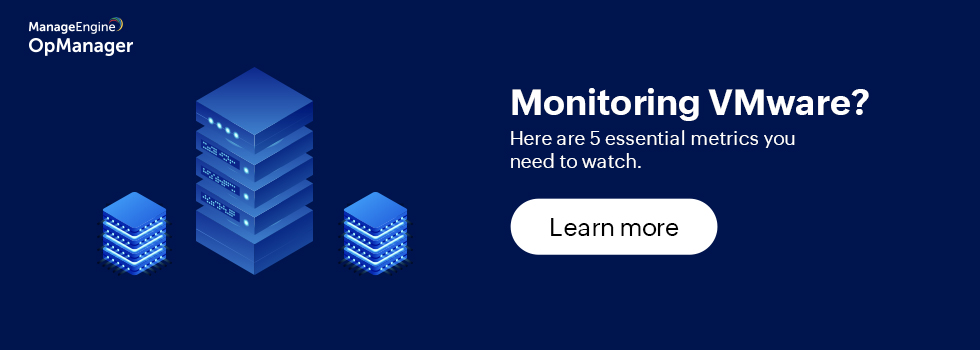
VMware enables businesses of all kinds to set up and employ virtual machines (VMs) and servers. These virtual instances provide an abundance of benefits, such as faster speeds, reduced costs, and reduced downtime. However, they can also be quite difficult to manage. Without the use of proper VMware monitoring solutions, these virtual instances can suffer severe performance loss.
Why should you monitor VMware?
The importance of monitoring VMware metrics for organizations cannot be understated. You need a good understanding of how your VMs are performing across your infrastructure to know whether they are functioning correctly. VMware infrastructure monitoring plays a vital role in preventing issues like VM sprawl and system downtime as well as ensuring your environment stays healthy and functions optimally.
Here are five metrics that must be tracked with a VMware monitoring tool:
1. Device performance
Monitoring VMware performance metrics is a critical step in keeping your VMs healthy. A VMware performance monitor ensures that all VMs, servers, CPUs, and other devices are running optimally. A single performance issue on a VM host not only affects the physical server but also all the VMs and their applications. It can result in huge losses for a company since businesses today host several devices and servers in a virtual environment. To prevent performance issues, you must set thresholds for individual devices and take proper remedial action when they are exceeded.
2. Resource utilization
Proper resource management is another important aspect of VMware monitoring. One of the major benefits of virtualization is being able to use a virtual environment to utilize resources that would otherwise be wasted. This purpose is defeated if resources are not properly allocated to and managed on a VM. Over- or under-allocation of resources to a VM leads to a waste or unbalanced use of resources. Proper monitoring of resource utilization metrics over time helps determine the appropriate allocation of resources to each VM.
3. Network performance
Network connectivity must also be monitored to ensure your VMs are performing as desired. Over-utilization of network bandwidth or excessive traffic on a single network interface card can severely impact the performance of all VMs. This is where VMware network monitoring is crucial. A VMware monitoring tool ensures all your virtual devices are connected to the network and are utilizing the appropriate bandwidth.
4. VM sprawl
VM sprawl refers to when the number of VMs in a network exceeds the management capacity of the administrators. Because sprawl occurs due to the gradual accumulation of VMs, admins usually don’t realize the problem until it’s quite serious. It can lead to unwanted VMs using up resources that they were supposed to save in the first place, like bandwidth, storage, and processing power. It’s also a huge risk to delete an existing VM without knowing its functions.
5. User experience
One of the most common problems end users face is slow applications. The ability to quickly and easily identify the root cause of such issues goes a long way towards ensuring your VMs perform optimally. Most VMware monitoring tools provide a visual representation of your virtual infrastructure to help you identify and diagnose any issues that occur.
Organizations require an appropriate tool to monitor VMware and keep their infrastructure in check. VMware monitoring tools assist with capacity planning and forecasting, spotting rogue VMs, and more. VMware infrastructure monitoring is vital and requires the deployment of dedicated, comprehensive software.
Monitor VMware performance with ManageEngine OpManager
OpManager’s VMware monitoring tool provides in-depth monitoring of VMware servers and keeps all devices in the virtual environment in check. OpManager monitors VMware servers via vCenter APIs. The advantage of using built-in APIs is that they don’t require any agent to be installed on the servers. The following are some of the many VMware monitoring aspects with which OpManager assists you.
Discovery
You can use OpManager to discover all the devices in a network, including servers. The VMware server hostname and its HTTPS credentials are all the solution needs to discover and monitor all of a host’s VMs. OpManager’s VMware monitoring tool automatically maps the VMs migrated via vMotion to the corresponding host.
Performance monitoring
OpManager’s VMware performance monitoring feature includes over 30 availability and performance monitors with preconfigured thresholds. You will be notified automatically when these thresholds are exceeded.
Managing resource-hungry VMs
You can use the VMware monitoring tool to identify resource-hungry VMs and take corrective action. OpManager provides extensive reports on VMware metrics like CPU, memory, and network utilization for every host and VM.
Relationship mapping
A vCenter map is a visual representation of your vCenter server topology. These maps show the relationships between the virtual and physical resources available to the vCenter server. Using the maps, you can monitor VM-centric relationships, host-centric relationships, data-store-centric relationships, and the hosts available for vMotion migration. vCenter maps help identify densely populated hosts, critical networks, and storage devices that are being utilized.
Visit ManageEngine OpManager for more information on how OpManager can assist your organization with VMware monitoring. You can also take a free online demo to learn more about OpManager.

